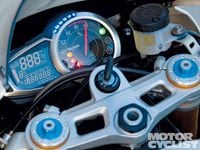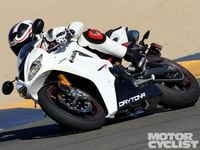R: It’s just the 18th letter of the alphabet, but when it’s attached to the end of a motorcycle’s moniker its impact can be enormous. Historically, the “R” suffix has indicated the inclusion of race-derived technology, performance upgrades or specialty parts. In the case of Triumph’s new Daytona 675R, it’s all of the above.
Hinckley’s latest middleweight sportbike has a roster of unique features and upgrades. Topping the list is the addition of an Öhlins NIX30 race fork, TTX36 shock, Brembo Monobloc front brake calipers and master cylinder, and an electronic quick-shifter. The bike comes in a distinctive Crystal White paint scheme with a red subframe, red-striped rims and loads of carbon-fiber. Numerous other parts have been painted black to complete the custom look, while plain-font logos convey the bike’s special designation. Other upgrades shared by the R-model and the standard 2011 Daytona 675 include an updated gearbox and a new, white-on-black LCD dash.
Considering the wealth of performance parts offered in Triumph’s race catalog, we’d hoped that the upgraded chassis components were added to complement increased engine output, but that’s not the case. Then again, the Daytona’s engine isn’t lacking. Redesigned in ’09, the motor produces over 100 horsepower and has nearly as much torque as a Suzuki GSX-R750. What’s best is that you don’t have to rev it out to access that power; Triumph’s distinctive triple melds low-end torque with a feisty top-end that makes the 675cc mill ideal for street and track use.
The North American press launch saw us aboard the new bike for one day in the Southern California mountains and another at Chuckwalla Valley Raceway. Ergonomically, the 675R is slightly different than the standard bike. The Öhlins fork is 5mm longer, elevating the front end and appreciably reducing weight on your wrists. The taller front end translates to slightly slower steering but also aids mid-corner stability, and on bumpy mountain roads the R felt steadier and more planted than my ’09 long-term Daytona did in similar conditions. Moving the fork down in the triple clamps to improve the bike’s composure is a common strategy among aggressive 675 riders; on the R-bike that setup is standard and there’s still another 5mm to experiment with.
On the track is where the new suspension shines. Chuckwalla features a challenging array of linked third- and fourth-gear bends, and we’re happy to report that the 675R chassis was more than up to the challenge. That wasn’t the case when I rode my ’09 bike there during the track’s inaugural event some months earlier. Then, I struggled with an imbalanced chassis that twitched and wallowed mid-corner and ran wide on exit.
Thankfully, the 675R’s Öhlins suspenders address all of those complaints. The tamed geometry, a softer shock spring, firmer fork springs and totally revised damping transform the Daytona into a calm and composed track scalpel. Previously a special-order part from the Swedish firm’s race catalog, Öhlins’ NIX30 fork makes its middleweight debut on the 675R. Bigger 43mm legs contain oversized 30mm cartridges, providing improved damping from the top of the stroke. Compression and rebound adjustments are separated to the left and right fork legs, respectively, and unlike on the base Daytona’s Kayaba suspension components, each click makes a noticeable difference. Out back, the MotoGP-derived TTX36 shock has easily accessible dials, making it easy to fine-tune the settings.
A transmission update sees first gear positioned closer to second as in the optional close-ratio racing gearbox. The cogs’ plain bearings also have been replaced with rollers, making for a noticeable improvement in shift action, especially during downshifts. The quick-shifter is excellent for full-throttle upshifts at the racetrack, but the ignition cutout lasts too long for part-throttle changes on the street, resulting in a disconcerting jolt in the lower gears.
Nothing looks more appropriate on an Öhlins fork than a pair of Brembo Monobloc radial-mount calipers, but the base model’s Nissin pinchers were some of the best-functioning brakes on the market and the Brembos exhibited some strange behavior. While they’re supposedly good for a 10 percent improvement in braking power, the big Brembos produced a strange front-end pulsation during heavy use that was apparent on all of the testbikes. If the goal was to hasten entry into corners, then the additional budget would have been better spent installing Triumph’s own accessory slipper clutch. As it is, the 675R wears all its upgrades on its sleeve, as the marketing types intended.
My only other complaint has to do with the new dash, which finds white characters positioned over a blacked-out background, making a somewhat cluttered readout even harder to decipher. Last year’s digital fuel gauge is mysteriously missing, although the fuel light still blinks on about 110 miles into your ride.
All-in-all, the new Daytona 675R lives up to its “R” suffix and represents a highly enhanced version of the standard machine. As remarkable as the handling improvement is, what’s more amazing is that the R-model only costs $1500 more than the $10,499 base Daytona. Purchased separately, the fork alone would cost twice that much! At $11,999 the 675R is only $400 more expensive than a GSX-R750 and fully a grand less than Ducati’s 848 EVO, making it an amazingly good deal for a prestige-brand European sportbike.
2011 Daytona 675R
Price $11,999
Evolution:
World-class suspension plus a few pieces from Triumph's accessory catalog elevate the Daytona to R-status.
Rivals:
Ducati 848 EVO, MV Agusta F3, Suzuki GSX-R750.
TECH SPEC
Engine type: l-c inline-triple
Valve train: DOHC, 12v
Displacement: 675cc
Bore x stroke: 74.0 x 54.3mm
Compression: 12.7:1
Fuel system: EFI
Clutch: Wet, multi-plate
Transmission: 6-speed
Claimed horsepower: 124 bhp @ 12,600 rpm
Claimed torque: 53 lb.-ft. @ 11,700
Frame: Aluminum twin-spar
Front suspension: 43mm Öhlins NIX30 fork with adjustable spring preload, compression and rebound damping
Rear suspension: Öhlins TTX36 shock with adjustable spring preload, compression and rebound damping
Front brake: Dual Brembo four-piston calipers, 308mm discs
Rear brake: Nissin single-piston caliper, 220mm disc
Front tire: 120/70ZR-17 Pirelli Diablo Supercorsa SP
Rear tire: 180/55ZR-17 Pirelli Diablo Supercorsa SP
Rake/trail: 23.9°/3.4 in.
Seat height: 32.7 in.
Wheelbase: 54.9 in.
Fuel capacity: 4.6 gal.
Claimed curb weight: 407 lbs.
Colors: Crystal white
Availability: Now
Warranty: 24 mo./unlimited mi.
Contact: Triumph Motorcycles of America, Ltd.
385 Walt Sanders Memorial Dr. #100
Newnan, GA 30265
770.447.5571
www.triumphmotorcycles.com
Verdict 4 out of 5 stars
Motorcyclist's 2006 Motorcycle of the Year made even better with top-shelf Öhlins suspension..
















/cloudfront-us-east-1.images.arcpublishing.com/octane/QCZEPHQAMRHZPLHTDJBIJVWL3M.jpg)
/cloudfront-us-east-1.images.arcpublishing.com/octane/HXOUJXQWA5HBHGRO3EMJIGFMVI.jpg)

/cloudfront-us-east-1.images.arcpublishing.com/octane/3TIWWRV4JBBOLDVGRYECVVTA7Y.jpg)
/cloudfront-us-east-1.images.arcpublishing.com/octane/KIX5O23D5NAIBGFXBN3327DKZU.jpg)
/cloudfront-us-east-1.images.arcpublishing.com/octane/7GJYDUIPXRGMTMQKN6ONYOLBOU.jpg)
/cloudfront-us-east-1.images.arcpublishing.com/octane/MUQLOVLL2ZDGFH25ILABNBXKTI.jpg)
/cloudfront-us-east-1.images.arcpublishing.com/octane/TNOU5DNE2BC57MFPMGN2EIDXAM.jpg)
/cloudfront-us-east-1.images.arcpublishing.com/octane/GTCXACQGJ5HAPDTGWUQKDEH44E.jpg)
/cloudfront-us-east-1.images.arcpublishing.com/octane/S35YGSEMEZB4BLTDJTSZPF4GLA.jpg)
/cloudfront-us-east-1.images.arcpublishing.com/octane/5UOT6HPX2JFMRJAX6EH45AR4MQ.jpg)
/cloudfront-us-east-1.images.arcpublishing.com/octane/OKWOJWAKP5EP3OACCRRWPCIX2Q.jpg)
/cloudfront-us-east-1.images.arcpublishing.com/octane/2WF3SCE3NFBQXLDNJM7KMXA45E.jpg)
/cloudfront-us-east-1.images.arcpublishing.com/octane/G4MG6OUCJNBSHIS2MVVOTPX65E.jpg)
/cloudfront-us-east-1.images.arcpublishing.com/octane/IIGGWFOTOJGB7DB6DGBXCCMTDY.jpg)
/cloudfront-us-east-1.images.arcpublishing.com/octane/QSTCM6AVEZA5JJBUXNIQ3DSOF4.jpg)
/cloudfront-us-east-1.images.arcpublishing.com/octane/U4I7G625B5DMLF2DVIJDFZVV6M.jpg)
/cloudfront-us-east-1.images.arcpublishing.com/octane/B6XD6LS6IVCQPIU6HXDJSM3FHY.jpg)
/cloudfront-us-east-1.images.arcpublishing.com/octane/ICL63FEDDRDTTMINYICCEYGMDA.jpg)
/cloudfront-us-east-1.images.arcpublishing.com/octane/FCGZHQXRBZFLBAPC5SDIQLVF4I.jpg)
/cloudfront-us-east-1.images.arcpublishing.com/octane/WNOB6LDOIFFHJKPSVIWDYUGOPM.jpg)

/cloudfront-us-east-1.images.arcpublishing.com/octane/X33NU3E525ECRHXLNUJN2FTRKI.jpg)
/cloudfront-us-east-1.images.arcpublishing.com/octane/6KKT5NNL2JAVBOXMZYS5ZO76YA.jpg)